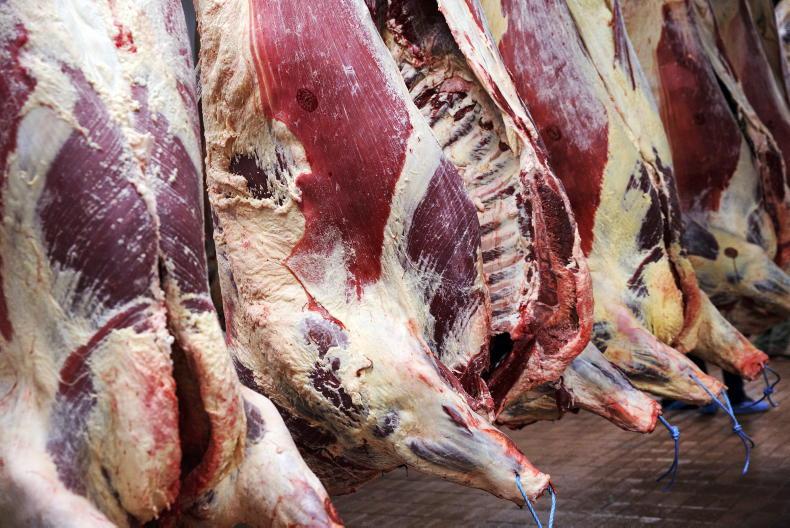They say that no two years are ever the same in the beef trade. The same goes for the weather and you could argue that it’s a combination of weather and trade that is currently impacting Irish beef markets.
The trade has been under pressure for the last month with factories chipping away with 5c/kg cuts for the last three to four weeks to bring most processors to a base price of €5/kg for bullocks and €5.05/kg for heifers this week.
This price falls a long way short of the €6/kg plus needed for shed-finished cattle to break even in 2024 and calls into question once again the merits of winter finishing. Factories have concentrated on their own supplies over the last few months and with their own “sustainability clubs” they have now more foresight than ever before of what is coming up the line in terms of kill numbers.
One in four cattle are now being slaughtered out of a controlled finishing unit or feedlot, a startling figure that conveys the power that processors have over finishers.
Processors are pointing to weaker demand in the UK and Europe. However, volumes exported to both markets are actually up for the first three months of 2024.
Supplies have stayed high and it’s this more than anything else that is currently placing pressure on the Irish price.
Bord Bia has estimated that the Irish kill will be down approximately 30,000 head in 2024 but the kill to date is currently up 32,000 head. A lot of cattle have remained indoors this spring and are currently being finished out of sheds as opposed to going to grass and coming in for slaughter in August and September.
These cattle are out of the system which coupled with the fact that there is potential for a 60,000 head swing less in cattle numbers between now and the end of year, is more positive for the second half of 2024.
Figure 1 outlines beef prices around Europe. While there are some markets not performing as well as anticipated, the UK, France and Italy remain well ahead of Irish prices.
These three countries currently account for 65% of Irish beef exports.
There are fears that 2024 will follow the same pathway as 2022 and 2023 and track downwards towards the backend.
The way the numbers are going would suggest that won’t happen in 2024 and the current good weather spell will see barbecues lighting up in many gardens.
Speaking at last week’s Irish Farmers Journal/KPMG breakfast briefing at Balmoral Show Joe McDonald from ASDA said that the company had its third highest day of sales ever for beef burgers, quite a different message than is currently emanating from Irish processors.
EU beef production is expected to decrease by 2.3% in 2024, following on from a 3.9% reduction in 2023. Italy saw a 17% drop in beef production in 2023.
Suckler cow numbers also dropped for the fourth year in a row across Europe, down by 160,000 in 2023 (-1.6%).
Consumption continues to be under pressure with it dropping by 4.7% in 2023 and forecast to be back 2.8% in 2024.
Despite this, imports from South America are expected to stay similar to 2023 with Brazil concentrating on the Chinese market.
Live exports from the EU increased by 7.4% in 2023 on the back of growth in the Turkish and Moroccan markets.
Large events such as the European football championships and the Paris Olympics are also expected to drive demand for beef products across Europe from June onwards.
The Irish R3 heifer price is currently 45c/kg behind the British price and 63c/kg behind the Italian price.Bord Bia predicts that the Irish kill will drop by 30,000 head in 2024. It is currently up 32,000 head.EU beef production is set to decrease by 2.3% in 2024.Exports of Irish beef to the EU are up 3% for the first three months of 2024.
They say that no two years are ever the same in the beef trade. The same goes for the weather and you could argue that it’s a combination of weather and trade that is currently impacting Irish beef markets.
The trade has been under pressure for the last month with factories chipping away with 5c/kg cuts for the last three to four weeks to bring most processors to a base price of €5/kg for bullocks and €5.05/kg for heifers this week.
This price falls a long way short of the €6/kg plus needed for shed-finished cattle to break even in 2024 and calls into question once again the merits of winter finishing. Factories have concentrated on their own supplies over the last few months and with their own “sustainability clubs” they have now more foresight than ever before of what is coming up the line in terms of kill numbers.
One in four cattle are now being slaughtered out of a controlled finishing unit or feedlot, a startling figure that conveys the power that processors have over finishers.
Processors are pointing to weaker demand in the UK and Europe. However, volumes exported to both markets are actually up for the first three months of 2024.
Supplies have stayed high and it’s this more than anything else that is currently placing pressure on the Irish price.
Bord Bia has estimated that the Irish kill will be down approximately 30,000 head in 2024 but the kill to date is currently up 32,000 head. A lot of cattle have remained indoors this spring and are currently being finished out of sheds as opposed to going to grass and coming in for slaughter in August and September.
These cattle are out of the system which coupled with the fact that there is potential for a 60,000 head swing less in cattle numbers between now and the end of year, is more positive for the second half of 2024.
Figure 1 outlines beef prices around Europe. While there are some markets not performing as well as anticipated, the UK, France and Italy remain well ahead of Irish prices.
These three countries currently account for 65% of Irish beef exports.
There are fears that 2024 will follow the same pathway as 2022 and 2023 and track downwards towards the backend.
The way the numbers are going would suggest that won’t happen in 2024 and the current good weather spell will see barbecues lighting up in many gardens.
Speaking at last week’s Irish Farmers Journal/KPMG breakfast briefing at Balmoral Show Joe McDonald from ASDA said that the company had its third highest day of sales ever for beef burgers, quite a different message than is currently emanating from Irish processors.
EU beef production is expected to decrease by 2.3% in 2024, following on from a 3.9% reduction in 2023. Italy saw a 17% drop in beef production in 2023.
Suckler cow numbers also dropped for the fourth year in a row across Europe, down by 160,000 in 2023 (-1.6%).
Consumption continues to be under pressure with it dropping by 4.7% in 2023 and forecast to be back 2.8% in 2024.
Despite this, imports from South America are expected to stay similar to 2023 with Brazil concentrating on the Chinese market.
Live exports from the EU increased by 7.4% in 2023 on the back of growth in the Turkish and Moroccan markets.
Large events such as the European football championships and the Paris Olympics are also expected to drive demand for beef products across Europe from June onwards.
The Irish R3 heifer price is currently 45c/kg behind the British price and 63c/kg behind the Italian price.Bord Bia predicts that the Irish kill will drop by 30,000 head in 2024. It is currently up 32,000 head.EU beef production is set to decrease by 2.3% in 2024.Exports of Irish beef to the EU are up 3% for the first three months of 2024. 









SHARING OPTIONS